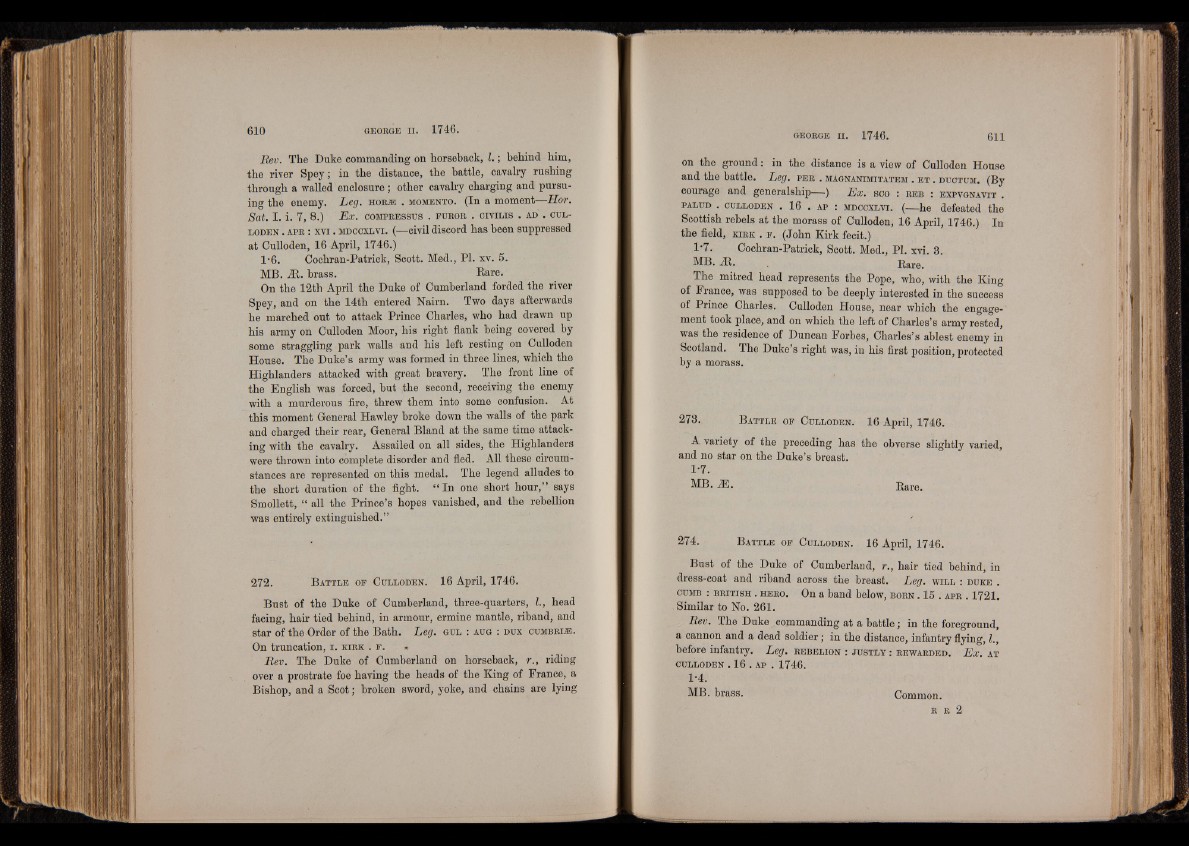
Rev. The Duke commanding on horseback, I. ; behind him,
the river Spey; in the distance, the battle, cavalry rushing
through a walled enclosure ; other cavalry charging and pursuing
the enemy. Leg. h o r s . m om en to . (In a moment—Hor.
Sat. I. i. 7, 8.) Ex. c om pr e s su s . fu r o r . c iv il is . ad . c u l l
o d e n . a p r : x v i. m dc c x lv i. (—civil discord has been suppressed
at Culloden, 16 April, 1746.)
1*6. Cochran-Patrick, Scott. Med., PI. xv. 5.
MB. iR. brass. Bare.
On the 12th April the Duke of Cumberland forded the river
Spey, and on the 14th entered Nairn. Two days afterwards
he marched out to attack Prince Charles, who had drawn up
his army on Culloden Moor, his right flank being covered by
some straggling park walls and his left resting on Culloden
House. The Duke’s army was formed in three lines, which the
Highlanders attacked with great bravery. The front line of
the English was forced, but the second, receiving the enemy
with a murderous fire, threw them into some confusion. At
this moment General Hawley broke down the walls of the park
and charged their rear, General Bland at the same time attacking
with the cavalry. Assailed on all sides, the Highlanders
were thrown into complete disorder and fled. All these circumstances
are represented on this medal. The legend alludes to
the short duration of the fight. “ In one short hour,” says
Smollett, “ all the Prince’s hopes vanished, and the rebellion
was entirely extinguished.”
272. B a t t l e o f C u l l o d e n . 16 April, 1746.
Bust of the Duke of Cumberland, three-quarters, I., head
facing, hair tied behind, in armour, ermine mantle, riband, and
star of the Order of the Bath. Leg. g u l : aug : d u x cumbrl®.
On truncation, i. k ir k . f . *
Rev. The Duke of Cumberland on horseback, r., riding
over a prostrate foe having the heads of the King of France, a
Bishop, and a Scot; broken sword, yoke, and chains are lying
on the ground : in the distance is a view of Culloden House
and the battle. Leg. p e r . m agn a n im itat em . e t . d u c tum . (By
courage and generalship— ) Ex. sco : r e b : ex pv g n a v it .
pa l u d . c u l l o d e n . 16 . a p : m dc c x lv i. (— he defeated the
Scottish rebels at the morass of Culloden, 16 April, 1746.) In
the field, k ir k . f . (John Kirk fecit.)
P7. Cochran-Patrick, Scott. Med., PI. xvi. 8.
MB. Æ. Bare.
The mitred head represents the Pope, who, with the King
of France, was supposed to be deeply interested in the success
of Prince Charles. Culloden House, near which the engagement
took place, and on which the left of Charles’s army rested,
was the residence of Duncan Forbes, Charles’s ablest enemy in
Scotland. The Duke’s right was, in his first position, protected
by a morass.
273. B a t t l e o f C u l l o d e n . 16 April, 1746.
A variety of the preceding has the obverse slightly varied,
and no star on the Duke’s breast.
1-7.
MB. M. Bare.
274. B a t t l e o f C u l l o d e n . 16 April, 1746.
Bust of the Duke of Cumberland, r., hair tied behind, in
dress-coat and riband across the breast. Leg. w il l : d u k e .
cumb : Br it i s h . h e r o . On a band below, bo rn . 15 . a pr . 1721.
Similar to No. 261.
Rev. The Duke commanding at a hattle; in the foreground,
a cannon and a dead soldier; in the distance, infantry flying, I.,
before infantry. Leg. r e b e l i o n : j u s t l y : r e w a r d e d . E x. a t
c u l l o d e n . 16 . a p . 1746.
1-4.
MB. brass. Common.
r r 2